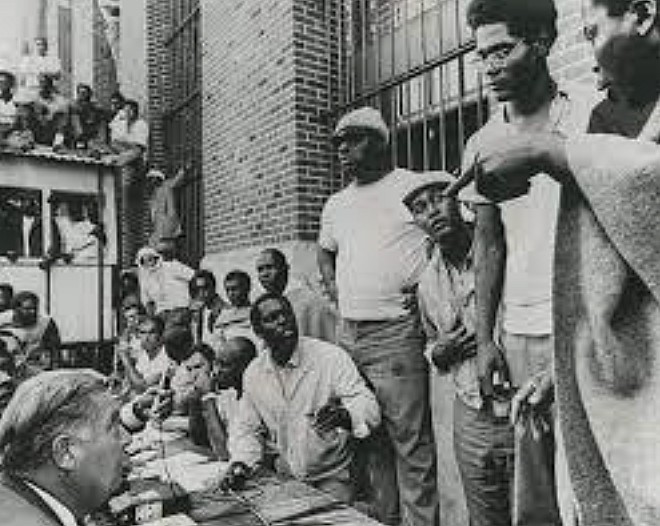Opinion Editorial
ATTICA: revisiting the roots of law and order
ATTICA, the Oscar-nominated documentary by Stanley Nelson and Traci Curry, earned its place as a poignant chronicle of the harrowing events of September 1971. Ironically, Sunday’s Academy Awards presenter Chris Rock got more of an apology from the actor who slapped him than the Attica Brothers ever got from the State of New York. In this piece co-written with Eileen Kelly, CEO Elizabeth Gaynes reflects on the ongoing struggle for humanization.
In a year when there is much debate about what history is, and how (and whether) we teach our children about our collective past, we see a struggle around its re-writing, re-learning, re-interpreting -- and then forgetting again. It is clearly true that it is uncomfortable to re-visit our country’s founding sin of enslaving Africans, but we don’t need to look that far back. The searing footage unleashed in a new documentary on an event in upstate New York half a century ago allows us – forces us – to visualize the slavemasters of the past and the Derek Chauvins of the present in one sweeping account of the massacre that ended the Attica Uprising.
The line that runs from chattel slavery, through Attica, to the murder of George Floyd (and others) is the belief that Black people in general, and Black people with conviction histories in particular, are less than human. The documentary produced by Stanley Nelson and Traci Curry illustrates the dictionary definition of dehumanization: “to deprive someone of human qualities…of dignity, to subject someone to inhuman or degrading conditions or treatment.”
At the same time, it is clear that the men in Attica’s D-Yard were demanding no more than to be treated as the human beings they are – and no less:
“We are men, we are not beasts, and we will not be beaten or driven as such.”
Other than the color of the participants, the scene was reminiscent of the portrait of Patrick Henry at a gathering of the Founding Fathers shouting “give me liberty.”


What strikes me in the documentary is the evidence - including photographs, filmed footage, contemporary news reports, and a taped conversation between Nelson Rockefeller and Richard Nixon, in which the Governor describes the State’s retaking of the prison - in which troopers and correction officers shot and killed 29 incarcerated men and 10 hostages - as “a beautiful thing,” reassuring the President that, “Oh yes, the whole thing was led by the Blacks.” How can it be that no one has ever been prosecuted for what happened there, including torture and executions committed by state actors whose motivation is given away by the correction officer filmed leaving the prison and shouting with near-orgasmic joy, “White power!”
I think of George Floyd, and our common understanding that Derek Chauvin would never have been charged, much less prosecuted and convicted, had there not been both a phone in the hand of a teenage girl brave enough to record a murder, and a media cosmos that made it nearly impossible for millions of Americans to avoid watching it.
The news reports of the Attica uprising, on the other hand, offered a glimpse of the horror – starting with the front page lie that the hostages had been killed by the incarcerated men (corrected days later) – serving mostly to justify the deadly assault. And most incarcerated men who were shot and killed died of “exsanguination” – because despite freely distributing .270 rifles with dumdum bullets to state troopers and correction officers, no provision was made for medical care.
As one of the lawyers for the Attica Brothers, I had seen mountains of photos; 45 years later, historian Heather Thompson’s Blood in the Water revealed additional proof of atrocities. But words and photos offer only a glimpse of the horrors that Stanley Nelson and Traci Curry showed in full motion on screen. Attica allows us to hear officers tell the Brothers “put your hands over your heads and you will not be harmed,” and then see them forced to crawl naked through the mud and tortured for days after. No wonder police fear no consequences for their “reckless disregard” to Black human life.
As the child of a Jewish-American soldier who helped liberate a concentration camp in Germany, I am as familiar as anyone with the cliched consequences for those who fail to remember the past. But there is also a need for the willingness to struggle with just consequences, whether they take the form of prosecutions, sanctions, apologies, amends and reparations, or 45,000-plus Stolpersteine (“stumbling stones”) memorializing victims of the Holocaust literally under the feet of European cities’ present-day pedestrians. (Imagine if there were “stumbling stones” in US cities where enslaved people once lived or individual Americans were murdered by police.) Apparently, it also requires videos, especially those that come to our personal devices, whether in the form of a powerful documentary like Attica or snippets posted by brave Ukrainians who are taking social media platforms invented to entertain and using them to document war crimes.
Attica breached the walls that separate incarcerated people from the public, allowing us to consider the implications for justice - both for those who survived Attica and for young Black and brown people surveilled, arrested, locked up, and under guard today. The next time a politician calls for the “law and order” policies of the bad old days – dialing back bail reform, resuming stop and frisk by any other name -- that led to mass incarceration, I suggest we all sit down and watch Attica again, and remember where this leads.